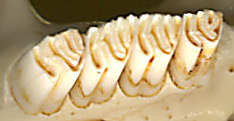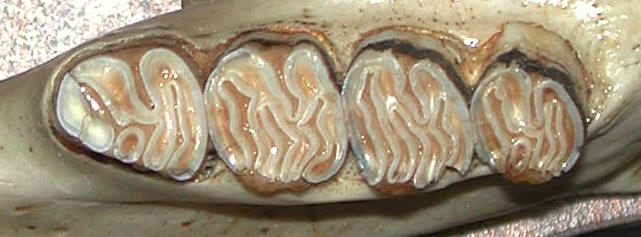There are only two extant species of beavers, the New World Castor canadensis and the Palearctic C. fiber. Beavers are known from the Oligocene and diverged into several different lines. One such line had fossorial adaptations, and the corkscrew-shaped fossil burrows were long a mystery. The Pleistocene semiaquatic form Castoroides reached the size of a black bear.
Smithsonian Fieldguide; Animal Diversity Web.
The Beaver's distribution went from all but northernmost North America south into northern Mexico, but avoided peninsula Florida, Southwestern streamless areas, and much of California and central Nevada. The pelage has long guard hairs and a dense underfur, and the fur trade resulted in the exploration of much of the West.
The beavers have a number of aquatic adaptations. Aside from being relatively large (giving a favorable surface area/volume ratio for reducing heat loss to the water) and with dense underfur, they also have a nictating membrane that protects the eye underwater. Nostrils and ears are both closable by valves. As with several other aquatic and semi-aquatic animals, the hind feet are webbed for greater surface area during swimming. The entrance to the trachea (epiglottis) lies above the soft palate, allowing breathing while the mouth is open; the shape of the tongue keeps water and material blocked from the esophagus except when swallowing.


Upper (left) and lower cheek teeth of the American Beaver.
Beavers are well known for manipulating their environment by building dams of sticks and mud. Dens are either underground and reached by a burrow which opens underwater or within a sticks and mud lodge, again with the entrance under water. The construction of a pond (by damming) thus protects the den, but it also extends the area from which food (the cambium layer of wood) can be harvested without traveling some distance from the protective water. In cold regions, wood is stored in the pond bottom where it can be recovered underwater even when the pond is covered with thick ice.
In the lower elevation areas of the Southwest, habitat generally is limited to rivers such as the Rio Grande or Pecos, where damming is impractical. Denning is usually within burrows, where the entrance is below the water line but the burrow angles upward to a chamber above the water table. In some areas in the past, a bounty was placed on beavers because of burrowing intersecting irrigation ditches with the resultant draining of these during the irrigation season.
Teeth are hypselodont. The tooth formula is 1/1, 0/0, 1/1, 3/3 = 20. The fourth premolar is molariform. The cheek teeth are complex, with three (in most teeth) deep folds on one side and one on the other.
Last Update: 12 Feb 2008
Centennial Museum and Department of Biological Sciences, The University of Texas at El Paso